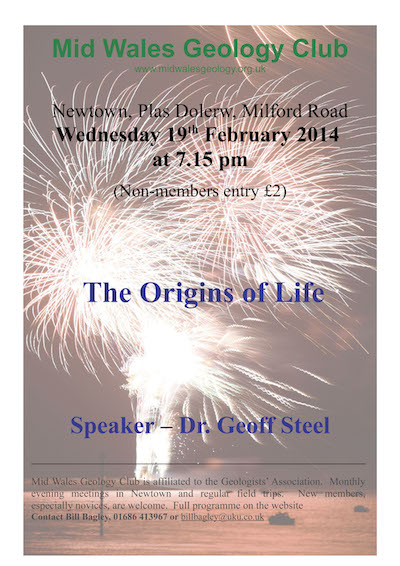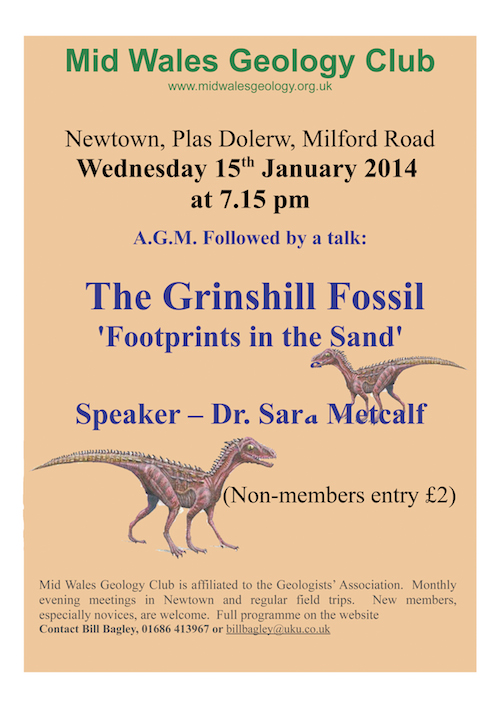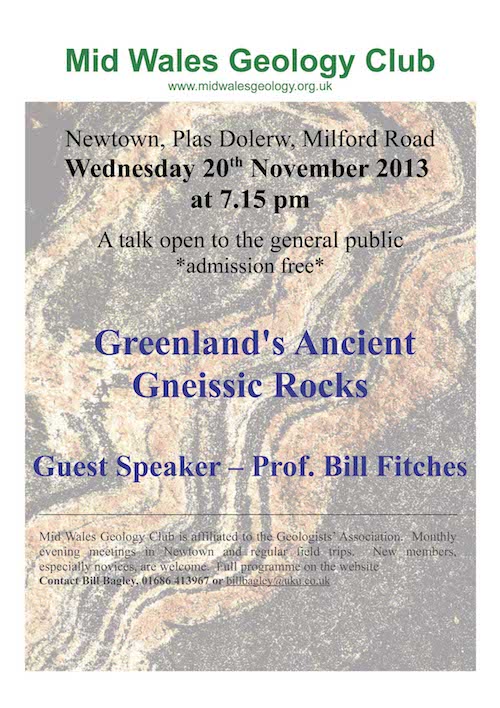Saturday 8th February 2014
The next indoor meeting will be on Wednesday 19th February where Dr Geoff Steel will give a talk entitled ‘The Origins of Life’.

The next indoor meeting will be on Wednesday 19th February where Dr Geoff Steel will give a talk entitled ‘The Origins of Life’.

Our first meeting of the year was the AGM for which 21 people attended. The AGM was followed by one of Dr Sara Metcalf's super talks. This time on the “Grinshill Fossil”.
On a club field trip to Grinshill quarry in 2013 the owners donated, to Powysland Museum Welshpool, a slab of Tarporley Siltstone containing a series of 19 fossilised footprints and rain drop pits. The talk given by Sara elucidated the current thinking on what formed the prints. Fossils of the herbivorous reptile Rhyncosaurus have previously been found at Grinshill and footprints found have been attributed to that reptile. She went on to say that the slab of Tarporley siltstone was Lower Anisian ( Middle Triassic) in age and would have been laid down in low energy rivers in an arid landscape. Recent re-evaluation of the so-called Rhyncosauroides footprints of Owen and others by Geoff Tresise of Liverpool Museum has shown them to be not related to the actual Rhyncosaur beast that has been found at Grinshill, but probably from a small archosaur reptile called a Protorosaur.
More photos of Sara's talk and the fossil footprints can be found on the Powysland Museum Facebook page.
The next meeting will be held on Wednesday 19th of February when Dr Geoff Steele will give a talk entitled “The Origins of Life”.
The next indoor meeting will be held on 15th January 2014. This will be the AGM to be followed by a talk given by Dr Sara Metcalf entitled: The Grinshill Fossil - Footprints in the Sand.

On 20th November Prof. Bill Fitches gave a talk on gneissic rocks, especially in Greenland, in particular those on the western margin of this huge territory, recalling the 1970s working for the Greenland Geological Survey, landed by helicopter to lead isolated mapping teams under canvas for weeks at a time in this beautiful but harsh environment. Greenland is on a craton (ancient continental crust) which extends east beneath the Outer Hebrides and north-west Scotland.
The oldest rocks are 3.75 Ga; even the youngest are 2.3 Ga, but these old rocks are often overprinted by younger events. The gneisses result from extreme metamorphism of mudstones at 600°C after burial up to 30 km deep. The structures at field scale are stunning. The minerals have migrated to large-scale dark and pale bands visible from long distance. In places the gneisses are sheared into puzzling structures, and sometimes extensively cross-cut by igneous dyke swarms. Rocks derived from shale similar to our Silurian black shales, but ten times older, was so metamorphosed that the carbonaceous content has segregated as graphite. Perhaps the organic material came from extremely primitive life 3 Ga ago. We were introduced to a new range of features including en-bayonet dykes, tennis ball gabbros and football anorthosites!
The talk concluded with a look at the Swiss Alps where Bill Fitches, during his time on the academic staff at Aberystwyth University, took students to see similar TTG gneisses (tonalite-trondhjemite-granodiorite) a hundred times younger than those in Greenland, and derived from Permian granites. The Matterhorn, in the alpine pennine nappes, shows rock of the ancient African continent thrust north over the top of European basement gneiss; between the two a band of rock formed from the oceanic crust and sediments of the floor of the long-gone Tethys ocean.
The next indoor meeting will be held on Wednesday 20th November, 7.15 pm at Plas Dolerw. Pfofessor Bill Fitches will present a talk entitled “Greenland’s Ancient Gneissic Rocks”
